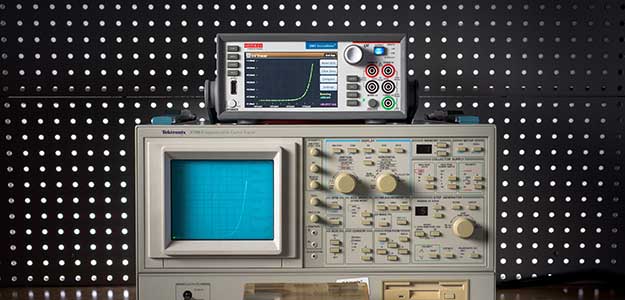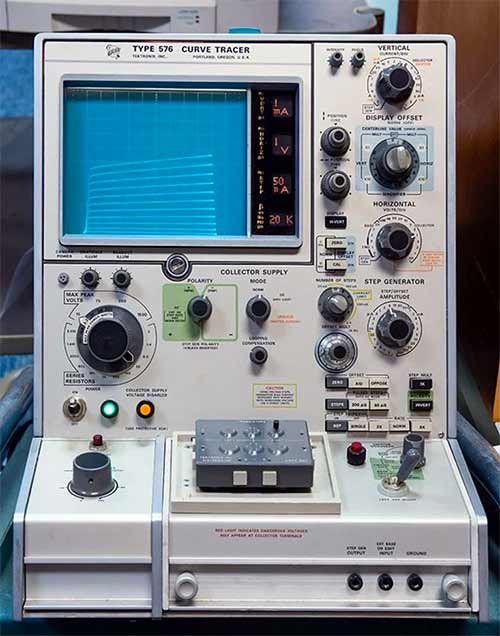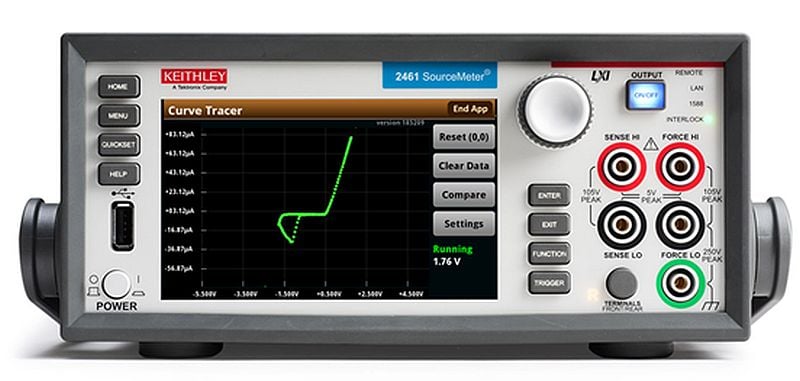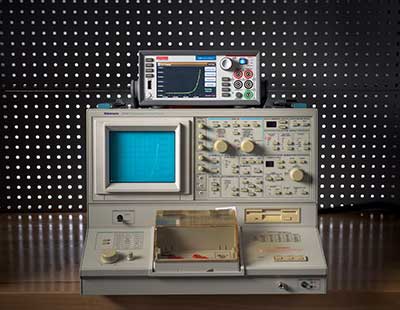

カーブ・トレーサは、 ダイオード、トランジスタ、サイリスタなどの半導体デバイスの特性を解析して、I-V曲線をトレースするために 使用する基本的な電子テスト・デバイス です。 故障解析やパラメトリック特性評価などのデバイス信頼性用途でよく使用されます。
テクトロニクスは、1955年に真空管の特性曲線を表示する業界初のカーブ・トレーサを発表しました。長年にわたり、トランジスタ、ダイオード、その他ソリッド・ステート・デバイスをテストするための、複雑で洗練されたモデルをリリースし続けてきました。

テクトロニクス576型カーブ・トレーサは 1969年に発売され、幅広い業界で受け入れられました。 ヴィンテージTEKミュージアムは、修復室での修理作業にこのトレーサを使用しています。詳細については、 こちらをご覧ください。
旧型カーブ・トレーサの需要
このような初期のモデルは、かつては故障の解析や教育目的で使用され、また現在も変わらず使用され続けています。人気の理由は、現代のカーブ・トレーサでは再現できない、ただ「ノブを回す」だけで曲線を画面に表示するようなユーザ・エクスペリエンスなど、シンプルなインタラクション・モデルであることが一因として挙げられます。こうした古いテクトロニクスカーブ・トレーサは製造終了となっているため、継続的な需要により、中古の旧型カーブ・トレーサ市場は堅調に推移し、370B型の再生品がオンライン・オークションで2万ドル以上で取引されています。
旧型のカーブトレーサを好んで使い続けている研究所では、ヴィンテージ計測器への依存が共通した問題となっています。使用可能な古い機器のコストを考慮して、研究所は通常、故障解析エンジニア全員で1台のユニットを共有しています。既存機器を使えるよう維持するには、旧型の交換部品を調達し、在庫しておく必要があり、限られた研究スペースの多くを設置面積に要してしまいます。 そして、データの取得や共有が簡単にできることを忘れてしまうのです。
最新のI-Vカーブ・トレーサの構成
TEKとケースレーは、テクトロニクスの旧型カーブ・トレーサに近い計測器 の必要性を認識し、2つのソリューションを導入しました。1つ目は、いわゆるケースレーPCT(パラメトリック・カーブ・トレーサ構成)で、特性評価エンジニアが完全なテスト・システムを開発するうえで必要なすべてを含んでいる I-V カーブ・トレーサ 構成 です。 これらの構成はモジュール式であるため、時間の経過とともにアップグレードすることができ、 ソース・メジャー・ユニットなどの個々の「ビルディング・ブロック」機器を、必要に応じて個別に他の 用途に使用できます。 これらの構成は、旧型のカーブ・トレーサに最も近いハードウェアですが、かなり大きな投資でもあります。そのため、研究所のニーズに応じた、よりシンプルなソリューションが存在します。
I-Vカーブ・トレーサ・ソフトウェア
ケースレーは最近、元々故障解析エンジニアがケースレー・ソースメータ®のソース・メジャー・ユニット(SMU)を使用して、2端子デバイス用旧型カーブ・トレーサで行っていたテストができるI-Vカーブ・トレーサ・ソフトウェア を発表しました。SMUは電圧や電流を印加しながら電圧や電流を計測できるため、カーブ・トレーサと同じハードウェア特性を備えています。
この新しいI-Vカーブ・トレーサ・ソフトウェアは、 2400シリーズ・グラフィカルSMU の直観的なタッチスクリーン・インタフェースを活用し、消費電力の低い2端子デバイス向けカーブ・トレーサの使い慣れたユーザーエクスペリエンスを再現しています。I-Vトレーサは、2461型のデュアル高速デジタイザなど、対応するSMUの機能をフルに活用して、標準のDC極性に加え、AC極性およびパルスDCでトレースを実行します。これが例えば、+DC、-DC、およびAC極性を持った576型にマッピングされます。つまり、出力が+電圧、-電圧のいずれか、または+電圧と-電圧の両方ということになります。

ケースレーのI-Vトレーサ・ソフトウェアは、2400シリーズ・グラフィカルSMUのタッチスクリーン・インタフェースを活用し、消費電力の低い2端子デバイス向けカーブ・トレーサの使い慣れたユーザ・エクスペリエンスを再現します。
I-Vカ曲線トレースへの経済的なアプローチ
これからは、研究室で共用の古い機器のためにリソースを蓄えておく代わりに、各エンジニアに個別にI-Vカーブ・トレーサを支給することが可能となります。ケースレーのSMUは持ち運びができ、下の370B型との比較にあるように、テスト・ベンチに容易に設置することができます。さらに、ケースレーSMUのソース、シンク、計測機能をすべて保持したまま、ほんの数クリック(またはタッチ)するだけでカーブ・トレーサ機能を利用できます。また、曲線やスクリーン・ショットのエクスポートも簡単で、スペア・パーツをオンライン・リストで探し回る必要もありません。
ケースレーのI-Vトレーサ・ ソフトウェアとSMUとの併用は、 ヴィンテージ機器のメンテナンスに伴う負担なしに、従来のカーブ・トレーサの使い勝手の良さを最大限に引き出すことができる、コスト・パフォーマンスに優れたアプローチとなります。

ケースレーI-Vトレーサ・ソフトウェアを搭載したSMUは、従来のカーブ・トレーサの数分の一のサイズです。
I-Vカーブ・トレーサ・ソフトウェアの用途
半導体デバイスの故障解析において、I-Vカーブ・トレーサは、細やかな制御と迅速に結果を提供できるという理由もあり、非常に人気があります。デバイスからの供給電力が大き過ぎると、障害の根本原因を示すセンシティブなエビデンスが破壊される可能性があります。I-Vトレーサは、出力レベルを直接制御することで、この機能をシミュレートします。これにより、故障解析(FA)エンジニアが、I-V曲線に異常が生じるまでゆっくりと出力を増加して、最小500nV(または500fA)の分解能を使い、印加された出力でそのまま動作を解析することができます。
カーブ・トレーサは、故障解析に加え、学生が学習内容を電気機器に直接応用できるシンプルさから、エンジニアリングのクラスで長い間必須のアイテムと考えられてきました。I-VトレーサとSMUとの併用も同様のメリットがあり、学生は、リアルタイムで直接制御機能をさまざまな電子機器に試し、理解を確実なものにすることができます。
用途に合ったソリューションを見つけるには、当社のI-V カーブ・トレーサ 構成 をご覧いただくか、ケースレーのI-Vカーブ・トレーサ・ソフトウェア とグラフィカル SMUの詳細をご覧ください。


